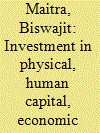| Srl | Item |
| 1 |
ID:
168503


|
|
|
|
|
| Summary/Abstract |
The objective of this study is to investigate the presence of ‘club convergence’ in respect of income among 15 major states in India during 1982–2014 using Markov chain along with stochastic kernel. The distributional dynamics observed among the major states support the process of ‘club convergence’. The empirical findings prove the hypotheses that economies that are similar in their structural characteristics and initial per capita income levels will converge with each other in per capita terms in the long run. The present study empirically re-establishes the hypotheses of ‘low-level equilibrium trap’ caused by low human capital investment.
|
|
|
|
|
|
|
|
|
|
|
|
|
|
|
|
| 2 |
ID:
147411


|
|
|
|
|
| Summary/Abstract |
Household education expenditure is an important component of human capital investment in children. In China, the rising child education expenditure and the subsequent financial burden on families have attracted much research and policy attention in the recent years. Using 2007 and 2011 data from the Urban Household Education Surveys, our empirical study provides new evidence on the education expenditure level, ratio of expenditure to household income, and inequality in this expenditure. We also elucidate changes in China's household education expenditure and explore factors associated with such changes. From the analysis, we obtain the following findings. First, education expenditure incurred outside the school significantly contributes to increasing household education expenditure. Second, compulsory education programs are effective in curbing in-school education expenditure; however, it does not prevent the rapidly increasing education investment outside school. Third, education expenditure disproportionally increases with family income. In other words, a larger share of the income earned by lower income families is spent on children's education, compared to higher income families.
|
|
|
|
|
|
|
|
|
|
|
|
|
|
|
|
| 3 |
ID:
161490


|
|
|
|
|
| Summary/Abstract |
This article studies the efficacy of the public investment in human capital and physical capital to raise income in Bangladesh over the period 1980–2016. This article also assesses whether the investment in human capital and income have raised life expectancy of the country. The Johansen cointegration test identifies a long-run relation of income with investment on education, health care and physical capital. The error correction mechanism (ECM) based on the cointegrating relation followed by the Wald test of Granger causality has found that these investments have caused income to rise with some lag periods. Robustness of these findings is confirmed by involving an autoregressive distributed lag (ARDL) model of cointegration followed by its ECM representation. On the other hand, the Johansen and ARDL methods of cointegration followed by their ECMs have also found a long-run relation of life expectancy with the investment in education, health care and income. A decisive role of the investment in health care and income on life expectancy is observed, while an unusual negative role of the investment in education is also found. However, positive value of the long-run coefficients of the education and health-care investments of the ECM-ARDL model indicate some long-run favourable impact of these investments on life expectancy in Bangladesh.
|
|
|
|
|
|
|
|
|
|
|
|
|
|
|
|
| 4 |
ID:
161833


|
|
|
|
|
| Summary/Abstract |
Using data from a rural household survey in China in 2009, we examine the impact of parental migration on children's educational outcomes. Consistent with the findings of a large empirical literature, we find that parental migration has a significantly negative impact on left-behind children's educational outcomes as measured by test scores in Chinese and math. But unlike much of the existing studies on the subject, we focus on the remediation effect of return migrant parents on once left-behind children's performance. This empirical strategy allows us to avoid the endogeneity issue concerning the migration decision that may have contaminated previous studies. We find evidence that return migrant parents help alleviate the harms caused by parental migration, and the remediation effect is stronger for children attending middle schools, and stronger for daughters. We also find suggestive evidence that return migrant parents improve children's performance through increases in after-school study time and education-related expenditures, following the return of migrant parents.
|
|
|
|
|
|
|
|
|
|
|
|
|
|
|
|